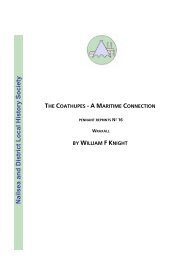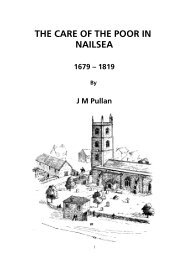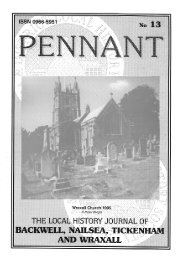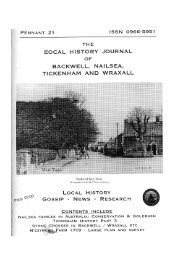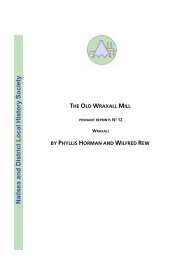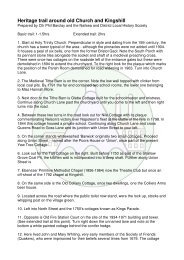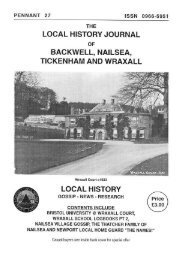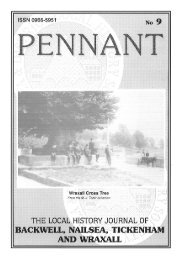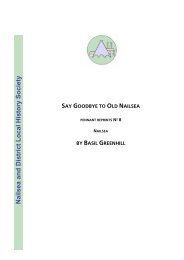No 17 - Nailsea and District Local History Society
No 17 - Nailsea and District Local History Society
No 17 - Nailsea and District Local History Society
Create successful ePaper yourself
Turn your PDF publications into a flip-book with our unique Google optimized e-Paper software.
Previously published by <strong>Nailsea</strong> & <strong>District</strong> <strong>Local</strong> <strong>History</strong> <strong>Society</strong>.This ebook version, © The respective authors <strong>and</strong> <strong>Nailsea</strong> & <strong>District</strong> <strong>Local</strong> <strong>History</strong><strong>Society</strong>, PO Box 1089, <strong>Nailsea</strong> BS48 2YP, has been made available in August2008, so that an individual may download <strong>and</strong> read this document, for privateresearch purposes only. It must not be reproduced or passed to a third partywithout written permission of the copyright holders
of public authorities, including Bedminster Poor law Union, the Court of theCounty Quarter sessions, <strong>and</strong> the diocese of Bath <strong>and</strong> Wells.An archivist will be available between 11am <strong>and</strong> 3-30pm at Weston-Super-Mareon the first <strong>and</strong> third Thursdays of every month, <strong>Nailsea</strong> on every secondThursday, <strong>and</strong> at various other local libraries on the fourth Thursday, includingClevedon on 26 th June <strong>and</strong> 25 th September. We hope you are able to make useof the <strong>No</strong>rth Somerset Archive Service. If you have any further queries please donot hesitate to contact the Record Office on (01823) 278805.The <strong>Nailsea</strong> Detached C Flightof 1446 (Clevedon) Squadron ATCLen Elverd who now lives in Backwell but whose parents ran a shop beside thevillage green in <strong>Nailsea</strong> told me that he was a member of the detached flight. Ihope to have a longer chat with him to find out more.The flight met in a big building adjacent to the Ring o’ Bells. The cadets went toseveral camps <strong>and</strong> flew occasionally. Len thinks that the planes used wereDakotas. Can anyone else comment on those far away days?2467 Squadron <strong>History</strong>by Peter WrightI am indebted to Mr R J Parke the Admin. Officer for the HQ Somerset Wing AirTraining Corps for the following information.2467 (NW Somerset) Squadron was formed on 6 th June 1967. 30 years on acelebration is due!2467 was formed in Long Ashton at the Army Cadet Force Hut in Keedwell Hillwith Flt Lt R W J Davies as its first CO.WO J M Gray <strong>and</strong> WO A E Robinson with CI D R G Reeves were the staffappointments at the commencement.The Committee Chairman was Wg. Cdr H Quittenden <strong>and</strong> later in 1967 Mr R.H.Ball <strong>and</strong> Sqn. Ldr. J. W. Wood were appointed.
In 1970 (29 th April) a detached flight was started at Portishead; this became asquadron in its own right on 16 th Dec1971.2467 moved to its own HQ in Church House Long Ashton sometime before <strong>No</strong>v1969.On 1 st <strong>No</strong>vember 1970 Flt Lt K B Hill assumed comm<strong>and</strong> of 2467 <strong>and</strong> with effectfrom 5 th March 1973 the squadron moved into its current HQ in GreenfieldCrescent <strong>Nailsea</strong>.Prior to this it had been in temporary quarters in the Army Cadet Force hut inWhitesfield Road.With effect from 1 st September 1983 Flt Lt Skinner took over comm<strong>and</strong> from FltLt Hill.He was followed by Flt Lt J H MacDonald from 1 st <strong>No</strong>vember 1984 <strong>and</strong> Flt LtTate from 28 th July 1986.Flt Lt Haggo the current CO joined the squadron as a CI on 1 st September 1987when authority was given to “recruit girls”. She became a WO in 1988subsequently taking a commission.She assumed comm<strong>and</strong> of 2467 Squadron in 1991.There are several long serving members of staff <strong>and</strong> also cadets still living in <strong>and</strong>around <strong>Nailsea</strong> so hopefully this item will be continued at a later date.From Vestry to Second Tierby Peter Weaver BEMfor many years Clerk to <strong>Nailsea</strong> Town CouncilThe story of the transition of Parish "local government" from the Vestry to thepresent Parish or Town Council is too long to be attempted in thissubmission.It is however just as important to our communities as the comparatively recent<strong>and</strong> well known attempts by central government to "rationalize" the principalauthorities. The recent abolition of the County authority in Avon in favour of
four "Unitary Authorities" has surely raised the Parish/Town Council from theofficially unrecognised third position to the second tier.<strong>Local</strong> Councils [a town council is a parish council by another name] celebratedtheir centenary in 1994 <strong>and</strong> we were reminded of the <strong>Local</strong> Government Act of1894 which created Parish Councils <strong>and</strong> the "transfer of certain powers ofvestry <strong>and</strong> other authorities to parish council".Prior to that time the affairs of the communities had been the subject ofdiscussion, <strong>and</strong> presumably resolution, at meetings of the inhabitants underthe roof <strong>and</strong> guidance of the Church, hence the name The Vestry.Charles Arnold-Baker in "<strong>Local</strong> Council Administration" suggests that meetingsof inhabitants in exp<strong>and</strong>ing populations had an inherent disadvantage; theybecome unwieldy <strong>and</strong> inefficient. In some cases a "committee", called "aSelect Vestry" was formed in an attempt to improve the situation but thesewere not popular <strong>and</strong> were said to be undemocratic. It is also evident thatthe Methodist revival <strong>and</strong> the objection to civil matters being dealt with by theestablished church lead to discontent. The Act of 1894 <strong>and</strong> the creation of ourParish Councils separated the civil from ecclesiastical functions of the Vestry. Itwas expected that there would be considerable opposition to this <strong>and</strong> initiallythere was some protest from the educated <strong>and</strong> wealthy who had previouslybeen influential in the community. This apparently did not last very long <strong>and</strong>the Parish Council fell into undeserved obscurity from which, in some cases, itis still suffering.The Councils, being statutory local authorities, are subject to countless Acts ofParliament which define their "Duties" <strong>and</strong> "Powers" At this time the dutiesare relatively few in number <strong>and</strong> are mainly concerned with the procedure forcalling, holding <strong>and</strong> the conduct of meetings.The most frequently quoted other duty is the requirement for the Council toconsider the provision of Allotments if it is of the opinion that there is aneed.If the "duties” are few the "Powers" of the Council are extensive. However aCouncil can only act if that action is supported by legislation so much of theClerk's time is taken up with ensuring that the Council is acting within thelaw. Fortunately, however, Sec 137 of the LG. Act 1972 permits a Council tospend up to a specified sum [at this time £3.50 per elector per year] on
anything of benefit to the community which it is not empowered to dounder other legislation. All this may change if a Bill under considerationbecomes law <strong>and</strong> the Councils are given "the Power of General Competence".In theory they will be able to do anything!!!The change in the status <strong>and</strong> power of the Vestry's successor authoritieswould surely astound our forefathers. The opportunities for our <strong>Local</strong>Councils, based on distinct communities, to play a greater part in our lives isenormous.Perhaps we should take a greater interest in their activities.New PublicationsBryan Button presented the <strong>Society</strong> with the text of an article <strong>and</strong> a copy of the1891 census.This proved to be too large for use in Pennant. We hope to publish the wholebook in the near future.We will use a method similar to the Parochial School Attendance Register but aswe go to press we underst<strong>and</strong> that to reproduce the whole of the Census willinfringe Crown Copyright.A feature of Bryan Button’s book which I found of particular interest was therevelation that so many people were born over 20 miles from Backwell.Editor’s note - <strong>No</strong>t wishing to find myself at odds with the Crown we willprobably produce the book with the names acting as an index to the Census.L<strong>and</strong> YeoKeith Gardner has information to supplement that published in “Mills on theL<strong>and</strong> Yeo” <strong>and</strong> ‘ Further Discoveries. We hope to publish Keith’s informationlater in 1997.
Behind the house is a two storey building still known as ‘the school room’; <strong>and</strong>some of the boys initials can still be seen cut into the cross beams supportingthe upper floor. Nearby is a former fives court built on to an end of a buttressedbarn. Under the encroaching ivy are scattered nails that once held the plasterthat gave a smooth surface for the game.The school was advertised in the Bristol Mirror in 1827 <strong>and</strong> again when a newheadmaster was appointed in 1841, but it came to an end in the eighteensixties,<strong>and</strong> for many years the building was used as a farmhouse.The finding of the hoard of Roman coins on the site of the school in 1808 is, ofcourse , a sure indication of the presence in this area of some kind of humanactivity in Roman times, but no other clues has been found to show where anyRoman building may have stood. <strong>No</strong> coins or pottery sherds have been reportedfrom the grounds around the building <strong>and</strong> there is no surface indication of anyancient structure here or in the neighbourhood. Pennant roofing tiles aresometimes found but these are no indication of Roman occupation for they maybe of any period since pennant found locally (in <strong>Nailsea</strong>) <strong>and</strong> can still be seen onbuildings st<strong>and</strong>ing today, for example, on an outhouse <strong>and</strong> small barn atBrockley Court Farm <strong>and</strong> on the entrance porch of Holy Trinity Church <strong>Nailsea</strong>which was repaired in <strong>17</strong>12.”Evacuees to <strong>Nailsea</strong>by Peter WrightSince the publication of the second of my books about the War years I havecontinued to seek further information. I was fortunate to receive a letter from aMrs Mitchell whose maiden name was Corney. Just as this edition of Pennantwas going to press I received a letter from her brother George who hasprovided the following information. At the time of writing I have not been ableto follow it up but will soon do so. Will any readers let me know if theyremember the family or can tell me about those who are also named.The following letter appeared in the local Kensington evening paper. Georgealso wrote about 40 letters but did not receive a single reply.Searching for local evacuees
Searching for local evacueesI’m trying to find anyone who was evacuated to <strong>Nailsea</strong> or Backwell in Bristolfrom Wornington Road LCC School situated in Wornington Road <strong>No</strong>rthKensington between September 1939 - 1940.A Londoner who now lives in <strong>Nailsea</strong> <strong>and</strong> is a member of the local historysociety is interested in any material - photographs, especially of the school,reminiscences, teachers or friends’ names - anything that would build up apicture of the kids from Kensington. My brothers <strong>and</strong> myself were put withfamilies in Union Street. Did we play with you? Were you neighbours of ours?We would love to hear evacuees’ memories. Please write Mrs Mitchell, 36Portl<strong>and</strong> Road, Ashford, Middlesex TW15 3BTA brief sample of those remembered are Mr & Mrs Reed of Ivy Cottage UnionStreet <strong>and</strong> son Fred (steward at the British Legion), Albert member of the FireBrigade <strong>and</strong> daughter Winnie who married Cyril Cridl<strong>and</strong> who was a butcher atthe Co-Op.Jim Corney <strong>and</strong> his mate Eddy Farr saw a plane l<strong>and</strong> on the Moors <strong>and</strong> “a chapgot out then the plane took off. He wore dark clothing <strong>and</strong> carried a large case.We thought he was a German Spy but nobody in authority believed us”.Eddy Farr was involved in another escapade when the boys on the way toschool “captured a loose barrage balloon <strong>and</strong> tried to tie it to a tree”. Whenthey got to school they told a teacher.Editor’s note - I hope to add more to the next editionFamily <strong>History</strong>We continue to receive enquiries from various parts of the globe. DavidChappell is fielding those via the Bristol <strong>and</strong> Avon FHS while Phyllis Horman <strong>and</strong>Phil Barclay are dealing with most of the remainder.George <strong>and</strong> Millie Knox keep an eye on enquiries from the Weston super mareFHS <strong>and</strong> your editor has most of the postal ones which he hurriedly passes on ifhe can.
Our recent acquisition from Gary Boudier of a tree for the LOCK family runningto more than 20 pages leads me to mention that in the Backwell 1891 censusthere are a number of LOCK family members mentioned.A Backwell War Memorialhas moved to the Churchyard.Readers may be interested to learn that the private war memorial to WilliamPatrick Garnett has been moved to the Churchyard of Backwell Church from itsoriginal site in the grounds of Backwell Hill House on the hillside overlookingBackwell. On the base is the following inscription“TO THE GLORY OF GODAND IN MOST HAPPY REMEMBRANCE OFPAT(WILLIAM PATRICK GARNETT) AGED 22LIEUT. 3 RD ROYAL BERKS REGT AND PILOT R.F.C.A MUCH LOVED ELDEST SON AND BROTHER KILLED ON THE WESTERN FRONTWHILST FLYING OVER THE GERMAN LINES ON MARCH 30 TH 19<strong>17</strong>.ALSO IN HONOURED AND GRATEFUL MEMORY OFCHRISTOPHER GEORGE BALLAGED 26 OF THE 12 TH BN GLOSTER REGTSECOND GARDENER ON THIS PLACEKILLED AT GUILLEMONT SEPT 3 RD 1916WILLIAM HENRY LOCKAGED 18 OF THE 2 ND WESSEX R.E.GARDEN BOY ON THIS PLACEKILLED AT DICKEBUSCH MARCH 5 TH 1915IN HIS LOVE AND HIS PITY HE REDEEMED THEM
Sir George Oatley (1863 - 1950) A Country connectionby John BrainThe article which follows refers to the Garnett memorial <strong>and</strong> has been providedfor publication by John Brain who wrote it as a contribution for the bellringers’national journal “The Ringing World”. The article is reproduced with theauthor’s permission from The Ringing World dated 28 th March 1997This is not in the true sense of the word a ringing story, but it is refreshingsometimes to look out the tower at the wider church, <strong>and</strong> in this instance tellthe tale of a chain of events which relate in a slightly different context to theeminent Bristol architect Sir George Oatley, whose involvement with GreatGeorge <strong>and</strong> the building of the University tower was so excellently chronicled inDavid Cawley’s article in January 24 th ’s edition of The Ringing World. SirGeorge’s architectural designs left the city with a rich heritage of fine buildingsearlier this century; he was also to become acquainted with our village, onlyseven miles from Bristol, in a totally different way, <strong>and</strong> to have an indirect effecton a project at our parish church here in Backwell completed only this week.As in all villages until relatively recent times, there was usually “the big house”with its local squire, who if you were lucky, could also be a village benefactor.Such a man was William Garnett, who lived at Backwell Hill House with hisfamily <strong>and</strong> a large retinue of servants - not quite “upstairs downstairs”, but verymuch a little community away from the village, the house st<strong>and</strong>ing in largegrounds with a comm<strong>and</strong>ing view over much of <strong>No</strong>rth Somerset <strong>and</strong> the BristolChannel to the Welsh Coast. Back in the 18 th century it was the home of J. R.Lucas, one of the owners of the nearby famous <strong>Nailsea</strong> Glassworks.William proved a generous benefactor in the upkeep of Backwell church, as wellas endowing it with a fine banner <strong>and</strong> processional cross, both still in use. Thefamily sat in their own pew in the Rodney chapel, opposite to where I sat as achoirboy. At our day school Mr Garnett also paid for free dental treatment forthe children for many years; how we dreaded the schoolmaster’s Friday rollcallfor that week’s intake, <strong>and</strong> the long walk to the surgery, but in an age beforethe National Health Service, free treatment was greatly appreciated by a nonetoo well off <strong>and</strong> largely agricultural community.Prior to the 1914 war Mr Garnett had decided on major rebuilding work to thefront of the house; Sir George was appointed architect, became a family friend,
<strong>and</strong> as so often in those circles, his daughter became engaged to William’seldest son Patrick.Down in the village another William, William Lott, worked as a builder <strong>and</strong>undertaker, as well as being a member of the local b<strong>and</strong> on the six bells as theywere then, although much of his ringing took place before the turn of thecentury when, as the rules of 1902 put it “in the event of a ringer being unableor not willing to ring, the next in order will be invited to fill his place”. Williamwas a skilled man in the building trade, self taught, producing <strong>and</strong> building tohis own designs <strong>and</strong> drawings, <strong>and</strong> he, <strong>and</strong> his workmen, were regularlyemployed by Mr Garnett at Backwell Hill House. Here he became acquaintedwith Oatley, <strong>and</strong> then became a friend, as their mutual respect for each other’scapabilities grew.William Lott’s ringing tradition passed from father to son via his uncle, who wasalso a builder in the village, <strong>and</strong> young Jim’s ringing career lasted from theGreat War until a couple of years ago. Perhaps his greater claim to fame hasbeen his chiming skills, dating back to the same era, <strong>and</strong> still a feature of thetower, although these days only on the first Sunday evening of the month.February 4 th was Jim’s 95 th birthday, <strong>and</strong> having lived in retirement in the samehouse all his life he still retains many memories of far gone village life, includingthe family’s association with Oatley. We sat in the kitchen, <strong>and</strong> Jim related theoccasion when Mr Garnett asked Sir George to design a couple of workmen’scottages for the estate. His reaction was to come to the house, <strong>and</strong> in that veryroom <strong>and</strong> in his plain speaking approach to tell Jim’s father that he was used tobuilding cottages to a gr<strong>and</strong>er design - country cottages were for countrybuilders, so it was to William’s specifications <strong>and</strong> on his advice that the planswere drawn up <strong>and</strong> the houses built. Only last year those plans were brought tolight <strong>and</strong> now take pride of place in the home of the present owner of theproperty.The horrors of the Great War spared few families, <strong>and</strong> Patrick Garnett’smarriage to Sir George’s daughter was short lived. As a young man of 22, as amember of the Royal Flying Corps, he was killed over enemy lines on theWestern Front on 30 th March 19<strong>17</strong>.The loss of his eldest son affected his father deeply, <strong>and</strong> he commissioned abeautiful almost life size figure of Christ on the Cross which was erectedprominently on heathl<strong>and</strong> just north of the house, to commemorate both
Patrick, <strong>and</strong> two young gardeners from his estate who had also given their livesin the conflict.The years passed by, the family grew up <strong>and</strong> left, new owners came <strong>and</strong> went,the heathl<strong>and</strong> became a forestry plantation, <strong>and</strong> the Calvary almost forgotten,its position known only to a few of us in the village who knew of itswhereabouts.It would probably have remained that way, a forgotten relic to be demolishedby a bulldozer when the timber crop was eventually harvested, had not ourrector, Patrick Blake (now retired) come across a letter on an old file from LadyAnstey, Patrick Garnett’s youngest sister, who lived in Southwell, enquiringabout the possibility of saving the Crucifix, <strong>and</strong> as part of our village history, reerectingit in the churchyard. Co-incidentally the churchyard was in need of anew area to be set aside for the interment of cremated remains, <strong>and</strong> the visionwas born to make the Calvary a focal point of the scheme. Patrick Blake’sinitiative <strong>and</strong> drive was to prove decisive.I will not bore reader’s with how the seemingly impossible task was translatedfrom vision into reality, especially the physical removal of an 11 foot monumentset in a stone base from a sloping woodl<strong>and</strong> with no road access, let alone theextensive consultations <strong>and</strong> Faculty preparation needed. Was it just coincidencethat our Church Architect who devised the scheme was Sir George Oatley’s lastpupil back in 1947?7 th February 1997 saw some of us involved in the project, churchwardens past<strong>and</strong> present, church architect Alan Rome, Laurence Tindall the fine art restorer,<strong>and</strong> Anthony Garnett from the family watch the lorry driver, with infinite skill,position <strong>and</strong> lower the Crucifix into its plinth, a perfect fit, <strong>and</strong> a beautiful workof art to grace its new setting. Dedication of the project will, we hope, be onEaster day, 30 th March (1997), 80 years to the day when Patrick Garnett gave hislife for his country. I’m sure both Sir George Oatley <strong>and</strong> William Garnett wouldhave approved.Planning for Future EventsAt the latest meeting of the Committee due note was taken of the approachingend / beginning of the millennium. It seems obvious that the choice of the timefor the celebration will be the night of 31/12/1999 - 1/1/2000 rather than themore correct one year later.
How should the <strong>Society</strong> celebrate? Suggestions to the Editor as soon as possibleplease.If you have read this far have you noticed a difference in this Pennant fromearlier editions?



